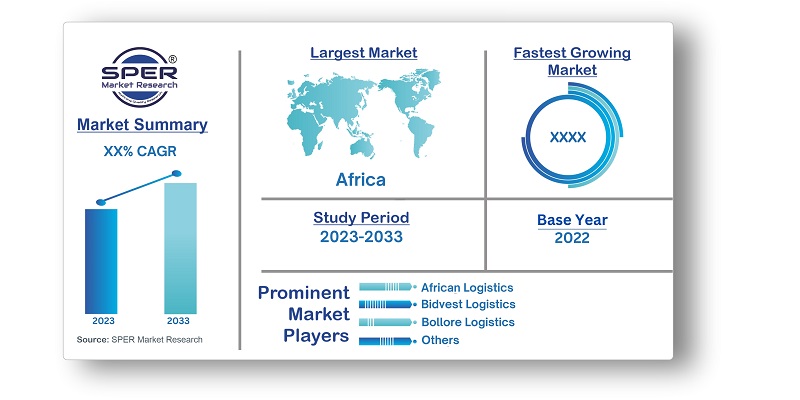
South Africa Logistics Market Growth, Trends, Size, Revenue, Scope, Challenges and Future Outlook
South Africa Logistics Market Size- By Service, By End User- Regional Outlook, Competitive Strategies and Segment Forecast to 2033
| Published: Jun-2023 | Report ID: AMIN2395 | Pages: 1 - 107 | Formats*: |
| Category : Automotive & Transportation | |||


| Report Metric | Details |
| Market size available for years | 2019-2033 |
| Base year considered | 2022 |
| Forecast period | 2023-2033 |
| Segments covered | By Service Mix, By End User |
| Regions covered | Johannesburg, Cape town, Durban, Port Elizabeth, Pretoria, Gauteng and rest of South Africa. |
| Companies Covered | African Logistics, Bidvest Logistics, Bollore Logistics, DB Schinke, DHL, DPD Group, Fastway Courier, FedEx, Kargo, Kuehne Nagel, Mega Freight, One Logix, Sacro CFR, Others |
- E-Commerce Companies
- Third-Party Logistics Providers
- Potential Market Entrants
- Freight Forwarding Companies
- Cold Storage Companies
- Government Bodies & Regulating Authorities
- South Africa Logistic Market Value Share and Forecast, By Service Mix, 2023-2033
- Freight Forwarding
- Warehousing
- Courier, Express parcel
- Value Added Services
- South Africa Logistics Market Value Share and Forecast, By End User, 2023-2033
- E-Commerce
- Retail
- Others
- Johannesburg
- Cape town
- Durban
- Port Elizabeth
- Pretoria
- Gauteng
- Rest of South Africa
- South Africa Logistics Market Size (FY’2023-FY’2033)
- Overview of South Africa Logistics Market
- Segmentation of South Africa Logistics Market By Service Mix (Freight Forwarding, Warehousing, Courier, Express Parcel, Value Added Services)
- Segmentation of South Africa Logistics Market By Type of End User (E-Commerce, Retail, Others)
- Statistical Snap of South Africa Logistics Market
- Growth Analysis of South Africa Logistics Market
- Problems and Challenges in South Africa Logistics Market
- Competitive Landscape in the South Africa Logistics Market
- Impact of COVID-19 and Demonetization on South Africa Logistics Market
- Details on Recent Investment in South Africa Logistics Market
- Competitive Analysis of South Africa Logistics Market
- Key Players in the South Africa Logistics Market
- SWOT Analysis of South Africa Logistics Market
- South Africa Logistics Market Future Outlook and Projections (FY’2023-FY’2033)
- Recommendations from Analyst
1.1. Scope of the report1.2. Market segment analysis
2.1. Research data source2.1.1. Secondary Data2.1.2. Primary Data2.1.3. SPER’s internal database2.1.4. Premium insight from KOL’s2.2. Market size estimation2.2.1. Top-down and Bottom-up approach2.3. Data triangulation
4.1. Driver, Restraint, Opportunity and Challenges analysis4.1.1. Drivers4.1.2. Restraints4.1.3. Opportunities4.1.4. Challenges4.2. COVID-19 Impacts of the South Africa Logistic Market
5.1. SWOT Analysis5.1.1. Strengths5.1.2. Weaknesses5.1.3. Opportunities5.1.4. Threats5.2. PESTEL Analysis5.2.1. Political Landscape5.2.2. Economic Landscape5.2.3. Social Landscape5.2.4. Technological Landscape5.2.5. Environmental Landscape5.2.6. Legal Landscape5.3. PORTER’s Five Forces5.3.1. Bargaining power of suppliers5.3.2. Bargaining power of buyers5.3.3. Threat of Substitute5.3.4. Threat of new entrant5.3.5. Competitive rivalry5.4. Heat Map Analysis
6.1. South Africa Logistic Market Manufacturing Base Distribution, Sales Area, Product Type6.2. Mergers & Acquisitions, Partnerships, Product Launch, and Collaboration in South Africa Logistic Market
7.1. South Africa Logistic Market Value Share and Forecast, By Service Mix, 2023-20337.2. Freight Forwarding7.2.1. By Sea7.2.2. By Road7.2.3. By Air7.2.4. By Rail7.3. Warehousing7.3.1. Retail/Industrial Warehouses7.3.2. CFS/ICD Warehouses7.3.3. Cold Storage7.3.4. Agriculture and Other Warehouse7.4. Courier, Express parcel7.5. Value Added Services
8.1. South Africa Logistic Market Value Share and Forecast, By End User, 2023-20338.2. E-Commerce8.3. Retail8.4. Others
9.1. South Africa Logistic Market Size and Market Share
10.1. South Africa Logistic Market Size and Market Share by Service Mix (2019-2026)10.2. South Africa Logistic Market Size and Market Share by Service Mix (2027-2033)
11.1. South Africa Logistic Market Size and Market Share by End User (2019-2026)11.2. South Africa Logistic Market Size and Market Share by End User (2027-2033)
12.1. South Africa Logistic Market Size and Market Share by Region (2019-2026)12.2. South Africa Logistic Market Size and Market Share by Region (2027-2033)12.3. Johannesburg12.4. Cape town12.5. Durban12.6. Port Elizabeth12.7. Pretoria12.8. Gauteng12.9. Rest of South Africa
13.1. African Logistics13.1.1. Company details13.1.2. Financial outlook13.1.3. Product summary13.1.4. Recent developments13.2. Bidvest Logistics13.2.1. Company details13.2.2. Financial outlook13.2.3. Product summary13.2.4. Recent developments13.3. Bollore Logistics13.3.1. Company details13.3.2. Financial outlook13.3.3. Product summary13.3.4. Recent developments13.4. DB Schinke13.4.1. Company details13.4.2. Financial outlook13.4.3. Product summary13.4.4. Recent developments13.5. DHL13.5.1. Company details13.5.2. Financial outlook13.5.3. Product summary13.5.4. Recent developments13.6. DPD Group13.6.1. Company details13.6.2. Financial outlook13.6.3. Product summary13.6.4. Recent developments13.7. Fastway Courier13.7.1. Company details13.7.2. Financial outlook13.7.3. Product summary13.7.4. Recent developments13.8. FedEx13.8.1. Company details13.8.2. Financial outlook13.8.3. Product summary13.8.4. Recent developments13.9. Kargo13.9.1. Company details13.9.2. Financial outlook13.9.3. Product summary13.9.4. Recent developments13.10. Kuehne Nagel13.10.1. Company details13.10.2. Financial outlook13.10.3. Product summary13.10.4. Recent developments13.11. Mega Freight13.11.1. Company details13.11.2. Financial outlook13.11.3. Product summary13.11.4. Recent developments13.12. One Logix13.12.1. Company details13.12.2. Financial outlook13.12.3. Product summary13.12.4. Recent developments13.13. Sacro CFR13.13.1. Company details13.13.2. Financial outlook13.13.3. Product summary13.13.4. Recent developments13.14. Skynet13.14.1. Company details13.14.2. Financial outlook13.14.3. Product summary13.14.4. Recent developments13.15. The Courier Guy13.15.1. Company details13.15.2. Financial outlook13.15.3. Product summary13.15.4. Recent developments13.16. Others
SPER Market Research’s methodology uses great emphasis on primary research to ensure that the market intelligence insights are up to date, reliable and accurate. Primary interviews are done with players involved in each phase of a supply chain to analyze the market forecasting. The secondary research method is used to help you fully understand how the future markets and the spending patterns look likes.
The report is based on in-depth qualitative and quantitative analysis of the Product Market. The quantitative analysis involves the application of various projection and sampling techniques. The qualitative analysis involves primary interviews, surveys, and vendor briefings. The data gathered as a result of these processes are validated through experts opinion. Our research methodology entails an ideal mixture of primary and secondary initiatives.



Frequently Asked Questions About This Report
PLACE AN ORDER
Year End Discount
Sample Report
Pre-Purchase Inquiry
NEED CUSTOMIZATION?
Request CustomizationCALL OR EMAIL US
100% Secure Payment






Related Reports
Our Global Clients
Our data-driven insights have influenced the strategy of 200+ reputed companies across the globe.




















